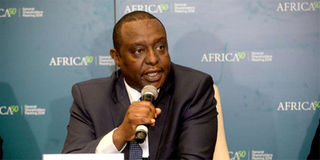Expensive loans expose Kenya to debt crisis

Treasury secretary Henry Rotich. Domestic debt repayments are projected at Sh506 billion while obligations to foreign creditors are budgeted at Sh364.7 billion. PHOTO | FILE | NATION MEDIA GROUP
What you need to know:
- The office estimates that 53.1 percent of the Sh562.8 billion the Treasury plans to borrow this financial year ending in June 2019, will come on commercial terms.
- Henry Rotich has budgeted Sh870.6 billion to pay off maturing domestic and external debt and accruing interest in the current year.
Increased uptake of commercial loans may plunge the country into a debt crisis, a parliamentary advisory team has warned.
The Budget Office, a professional unit within the National Assembly which advises legislators on financial, budgetary and economic matters, is worried the contraction of expensive loans will put pressure on Kenya’s dollar reserves.
The office estimates that 53.1 percent of the Sh562.8 billion the Treasury plans to borrow this financial year ending in June 2019 will come on commercial terms.
“In financial year 2018/19, commercial debt is estimated at Sh298.9 billion and will be the largest source of financing for the country’s Sh562.8 billion budget deficit,” the office warns in its latest Budget Watch report.
“Commercial loans are expensive and a leaning towards this trend is increasing the country’s debt service.”
ROADS
Treasury Cabinet Secretary Henry Rotich has budgeted Sh870.6 billion to pay off maturing domestic and external debt and accruing interest in the current year.
Domestic debt repayments are projected at Sh506 billion while obligations to foreign creditors are budgeted at Sh364.7 billion.
President Uhuru Kenyatta’s administration has been contracting short-term domestic debt since September 2014 to build economic growth — enhancing roads, bridges, power plants and the standard gauge railway.
That started after Kenya became a lower middle income economy, locking her out of highly concessional loans from development lenders such the World Bank Group’s International Development Association.
Commercial loans accounted for 36 percent of the country’s Sh2.6 trillion total external debt at the end of June, statistics show, thanks to the $2 billion (Sh201.4 billion) Eurobond the Treasury took out in February.
GPD
Kenya’s total public debt stood at Sh5 trillion at the end of the last financial year in June, a growth of 14.3 percent over Sh4.4 trillion a year earlier.
At 49 percent of the gross domestic product (GDP) — national wealth — in net present value terms, the country’s debt was just shy of the 50 percent mark stipulated under the Public Finance Management Framework and way below the 74 percent threshold recommended by the International Monetary Fund.
The debt as at June was, however, 58 percent of the GDP when inflation and price changes are not factored, meaning nearly 60 percent of Kenya’s gross national wealth was in debt.
“The emerging concern is that the government’s appetite for borrowing seems unlikely to wane any time soon and this could eventually push debt towards unsustainable levels,” the office said.
“It is important, therefore, to ensure that money accrued from debt is well utilised and any public investment inefficiencies are effectively addressed to ensure that debt funded projects yield high economic returns.”
SUSTAINABLE
Mr Kenyatta’s administration has contracted Sh3.2 trillion in new debt since taking the reins of power when debt stock was Sh1.9 trillion in June 2013.
Nearly Sh2.1 trillion more debt is set to be contracted in the next four years to June 2022, according the draft 2018 Budget Review and Outlook Paper by the Treasury.
Treasury Principal Secretary Kamau Thugge has maintained that while the country has been accumulating debt at a faster rate than previous regimes, it remains sustainable and it is stimulating growth in the economy.
A projected drop in budget deficit from 6.7 percent of GDP in the last financial year which ended in June to 5.7 percent and further to 4.6 percent in 2019/20 and 3.5 percent in 2020/21, Dr Thugge said, will keep borrowing at manageable levels.
“We have been able to manage our debt to GDP. We have a plan going forward on how to address debt and we should not be concerned that we are acquiring too much debt which is unsustainable,” Dr Thugge said earlier this month.
“As we reduce our fiscal deficit, it means we are accumulating debt at a slower pace and our economy is growing.”
TAXES
The Treasury has pledged to ensure efficient and effective use of public funds with ministries, departments and agencies required to justify how every shilling they request from the exchequer will contribute to the Big Four projects.
The measures, under what is known as zero-based budgeting within the Treasury, together with increased tax collections are aimed at cutting the budget deficit, thus cutting the government’s appetite.
Economists have cheered the measures aimed at cutting expenditures on projects with little impact on growth.
“The underlying problem has been we were borrowing and we were not seeing dollar returns being generated,” Jibran Qureishi, Stanbic Bank economist for East Africa, said.
“We need to reassess what we are paying for, the costs for it and do a stringent feasibility study to ensure there’s a multiplier effect on the wider economy. That’s when you can justify that external debt will ultimately be supporting growth.”
The largest chunk of infrastructure projects has been funded by semi-concessional loans from China which controlled about 68 per cent of Kenya’s bilateral debt as at the end of June.





